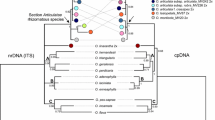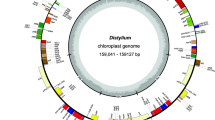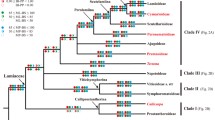Abstract
The Ulmaceae is usually split into two subgroups, referred to as either tribes or more commonly subfamilies (Ulmoideae andCeltidoideae). The two groups are separated, with some exceptions, on the basis of leaf venation, fruit type, seed morphology, wood anatomy, palynology, chemistry, and chromosome number. Propositions to separate the two groups as distinct families have never gained general acceptance. Recent morphological and anatomical data have suggested, however, that not only is family status warranted but thatCeltidaceae are more closely related toMoraceae and otherUrticales than toUlmaceae. In order to test these alternative sets of relationships, restriction site mapping of the entire cpDNA was done with nine rare cutting enzymes using 11 genera ofUlmaceae s. l., three other families of theUrticales, and an outgroup family from theHamamelidae. Cladistic analysis of the data indicates thatUlmaceae s. l. is not monophyletic and that distinct families (Ulmaceae andCeltidaceae) are warranted; thatUlmaceae is the sister group toCeltidaceae plus all other families in the order; and thatCannabaceae might be nested withinCeltidaceae. Familial placements of various problematic genera (e.g.Ampelocera, Aphananthe) are resolved and character evolution of key morphological, anatomical, chemical, and chromosomal features are discussed.
Similar content being viewed by others
References
Albert, V. A., Mishler, B. D., Chase, M. W., 1992: Character-state weighting for restriction site data in phylogenetic reconstruction, with an example from chloroplast DNA. — InSoltis, P. S., Soltis, D. E., Doyle, J. J., (Eds): Molecular systematics of plants, pp. 369–403. — New York: Chapman & Hall.
Baum, D. A., Sytsma, K. J., Hoch, P. C., 1994: The phylogeny ofEpilobium L. (Onagraceae) based on nuclear ribosomal ITS sequences. — Syst. Bot.19: 363–388.
Behnke, H.-D., 1989: Sieve-element plastids, phloem proteins, and the evolution of flowering plants. IV.Hamamelidae. — InCrane, P. R., Blackmore, S., (Eds): Evolution, systematics, and fossil history of theHamamelidae,2: ‘Higher’Hamamelidae. — Syst. Assoc. Spec. Vol.40-A, pp. 105–128. — Oxford: Clarendon Press.
Berg, C. C., 1977:Urticales, their differentiation and systematic position. — Pl. Syst. Evol., Suppl.1: 349–374.
, 1989: Systematics and phylogeny of theUrticales. — InCrane, P. R., Blackmore, S., (Eds): Evolution, systematics, and fossil history of theHamamelidae,2: ‘Higher’Hamamelidae. — Syst. Assoc. Spec. Vol.40-B, pp. 193–220. — Oxford: Clarendon Press.
Bremer, K., 1988: The limits of amino acid sequence data in angiosperm phylogenetic reconstruction. — Evolution42: 795–803.
Chase, M. W., Soltis, D. E., Olmstead, R. G., Morgan, D., Les, D. H., Mishler, B. D., Duvall, M. R., Price, R. A., Hills, H. G., Qiu, Y., Kron, K. A., Rettig, J. H., Conti, E., Palmer, J. D., Manhart, J. R., Sytsma, K. J., Michaels, H. J., Kress, W. J., Karol, K. G., Clark, W. D., Hedrén, M., Gaut, B. S., Jansen, R. K., Kim, K.- J., Wimpee, C. F., Smith, J. F., Furnier, G. R., Strauss, S. H., Xiang, Q.-Y., Plunkett, G. M., Soltis, P. S., Swensen, S. M., Williams, S. E., Gadek, P. A., Quinn, C. J., Eguiarte, L. E., Golenberg, E., Learn, G. H., Graham, S. W., Barrett, S. C. H., Dayanandan, S., Albert, V. A., 1993: Phylogenetics of seed plants: an analysis of nucleotide sequences from the plastid generbcL. — Ann. Missouri Bot. Gard.80: 528–580.
Chernik, V. V., 1975: Arrangements and reduction of perianth and androecium parts in representatives ofUlmaceae Mirbel andCeltidaceae Link. — Bot. Zhurn. (Leningrad)60: 1561–1573.
, 1980: Peculiarities of structure and development of the pericarp of the representatives of the familyUlmaceae andCeltidaceae. — Bot. Zhurn. (Leningrad)65: 521–531.
Cronquist, A., 1981: An integrated system of classification of flowering plants. — New York: Columbia University Press.
, 1988: The evolution and classification of flowering plants. 2nd edn. — Bronx, NY: New York Botanical Garden.
Dahlgren, R., 1983: General aspects of angiosperm evolution and macrosystematics. — Nordic J. Bot.3: 119–149.
Donoghue, M. J., Olmstead, R. G., Smith, J. F., Palmer, J. D., 1992: Phylogenetic relationships ofDipsacales based onrbcL sequences. — Ann. Missouri Bot. Gard.79: 333–345.
, Sanderson, M. J., 1992: The suitability of molecular and morphological evidence in reconstructing plant phylogeny. — InSoltis, P. S., Soltis, D. E., Doyle, J. J., (Eds): Molecular systematics of plants, pp. 340–368. — New York: Chapman & Hall.
Engler, A., Prantl, K., 1893: Die natürlichen Pflanzenfamilien.3. — Berlin: Bornträger.
Erdtman, G., 1971: Pollen morphology and plant taxonomy. — New York: Hafner.
Farris, J. S., 1970: Methods for computing Wagner trees. — Syst. Zool.19: 83–92.
, 1989: The retention index and homoplasy excess. — Syst. Zool.38: 406–407.
Felsenstein, J., 1978: Cases in which parsimony or compatibility will be positively misleading. — Syst. Zool.27: 401–410.
, 1985: Confidence limits on phylogenies: an approach using the bootstrap. — Syst. Zool.39: 783–791.
, 1992: PHYLIP manual version 3.4. — Berkeley: University of California Herbarium.
Giannasi, D. E., 1978: Generic relationships in theUlmaceae based on flavonoid chemistry. — Taxon27: 331–344.
Givnish, T. J., 1987: Comparative studies of leaf form: assessing the relative roles of selective pressures and phylogenetic constraints. — New Phytol.106, Suppl.: 131–160.
, Sytsma, K. J., 1997a: Homoplasy in molecular vs. morphological data: the likelihood of correct phylogenetic inference. — InGivnish, T. J., Sytsma, K. J., (Eds): Molecular evolution and adaptive radiation. — New York: Cambridge University Press.
,, 1997b: Consistency, characters, and the likelihood of correct phylogenetic inference. — Molec. Phylogenet. Evol.7: 320–333.
Grudzinskaya, I. A., 1967:Ulmaceae and reasons for distinguishingCeltidoideae as a separate familyCeltidaceae Link. — Bot. Zhurn. (Leningrad)52: 1723–1749.
Gunter, L. E., Kochert, G., Giannasi, D. E., 1994: Phylogenetic relationships of theJuglandaceae. — Pl. Syst. Evol.192: 11–29.
Holsinger, K. E., Jansen, R. K., 1993: Phylogenetic analysis of restriction site data. — Meth. Enzymol224: 23–37.
Hufford, L., 1992:Rosidae and their relationships to other nonmagnoliid dicotyledons: a phylogenetic analysis using morphological and chemical data. — Ann. Missouri Bot. Gard.79: 218–248.
Humphries, C. J., Blackmore, S., 1989: A review of the classification of theMoraceae. — InCrane, P. R., Blackmore, S., (Eds): Evolution, systematics, and fossil history of theHamamelidae,2: ‘Higher’Hamamelidae. — Syst. Assoc. Spec. Vol.40-B, pp. 267–277. — Oxford: Clarendon Press.
Hutchinson, J., 1967: The genera of flowering plants.2. — Oxford: Clarendon Press.
Jansen, R. K., Michaels, H. J., Wallace, R. S., Kim, K. -J., Keeley, S. C., Watson, L. E., Palmer, J. D., 1992: Chloroplast DNA variation in theAsteraceae: phylogenetic and evolutionary implications. — InSoltis, P. S., Soltis, D. E., Doyle, J. J., (Eds): Molecular systematics of plants, pp. 252–279. — New York: Chapman & Hall.
Palmer, J. D., 1988: Phylogenetic implications of chloroplast DNA restriction site variation in theMutisieae (Asteraceae). — Amer. J. Bot.75: 753–766.
Judd, W. S., Sanders, R. W., Donoghue, M. J., 1994: Angiosperm family pairs: preliminary phylogenetic analyses. — Harvard Pap. Bot.5: 1–51.
Klotzsch, J. F., 1847: Beiträge zu einer Flora der Aequinoctial-Gegenden der Neuen Welt. — Linnaea20: 337–542.
Kluge, A. G., Farris, J. S., 1969: Quantitative phyletics and the evolution of anurans. — Syst. Zool.18: 1–32.
Kuprianova, L. A., 1962: [Palynological data for the systematics of the ordersFagales andUrticales.] k pervoi mezhdunarodnoi palinologicheskoi konferentsii doklady sovetskikh palinologov. — Proceedings of the First International Conference on Palynology 1962, Tucson, AZ, pp. 17–25 (In Russian).
Lindley, J., 1853: The vegetable kingdom. 3rd edn. — London: Bradbury & Evans.
Link, D. H. F., 1831: Handbuch zur Erkennung der nutzbarsten und am häufigsten vorkommenden Gewächse2. — Berlin: Haude & Spener.
Mabberely, D. J., 1987: The plant-book: a portable dictionary of the higher plants. — Cambridge: Cambridge University Press.
Maddison, W. P., Maddison, D. R., 1992: MacClade: Analysis of phylogeny and character evolution, version 3.0. — Sunderland, Massachusetts: Sinauer.
Manchester, S. R., 1989: Systematics and fossil history of theUlmaceae. — InCrane, P. R., Blackmore, S., (Eds): Evolution, systematics, and fossil history of theHamamelidae,2: ‘Higher’Hamamelidae. — Syst. Assoc. Spec. Vol.40-B, pp. 221–251. — Oxford: Clarendon Press.
Mehra, P. N., Gill, R. S., 1974: Cytological studies inUlmaceae, Moraceae andUrticaceae. — J. Arnold Arbor.55: 663–677.
Mirbel, C. F., 1815: Éléments de physiologie végétale et de botanique. — Paris: Magimel.
Nei, M., Li, W. -H., 1979: Mathematical model for studying genetic variation in terms of restriction endonucleases. — Proc. Natl. Acad. Sci. USA76: 5269–5273.
, Tajima, F., 1985: Evolutionary change of restriction cleavage sites and phylogenetic inference for man and apes. — Molec. Biol. Evol.2: 189–205.
Oginuma, K., Raven, P., Tobe, H., 1990: Karyomorphology and relationships ofCeltidaceae andUlmaceae (Urticales). — Bot. Mag. (Tokyo)103: 113–131.
Olmstead, R. G., Palmer, J. D., 1992: A chloroplast DNA phylogeny of theSolanaceae: subfamilial relationships and character evolution. — Ann. Missouri Bot. Gard.79: 346–360.
,, 1994: Chloroplast DNA systematics: a review of methods and data analysis. — Amer. J. Bot.81: 1205–1224.
, Sweere, J. A., 1994: Combining data in phylogenetic systematics: an empirical approach using three molecular data sets in theSolanaceae. — Syst. Biol.43: 467–481.
Omori, Y., Terabayashi, S., 1993: Gynoecial vascular anatomy and its systematic implications inCeltidaceae andUlmaceae (Urticales). — J. Pl. Res.106: 249–258.
Palmer, J. D., Jansen, R. K., Michels, H. J., Chase, M. W., Manhart, J. R., 1988: Chloroplast DNA variation and plant phylogeny. — Ann. Missouri Bot. Gard.75: 1180–1206.
Planchon, J. -E., 1873:Ulmaceae. — InCandolle, A. P. De, (Ed.): Prodromus systematis naturalis regni vegetabilis.17. — Paris: Truettel & Würtz.
Raven, P. H., 1975: The bases of angiosperm phylogeny: cytology. — Ann. Missouri Bot. Gard.62: 724–764.
Saitou, N., Nei, M., 1987: The neighbor-joining method: a new method for reconstructing evolutionary trees. — Molec. Biol. Evol.4: 406–425.
Sanderson, M. J., 1989: Confidence limits in phylogenies: the bootstrap revisited. — Cladistics5: 113–129.
, Donoghue, M. J., 1989: Patterns of variation in levels of homoplasy. — Evolution43: 1781–1795.
Shinozaki, K., Ohme, M., Tanaka, M., & al., 1986: The complete nucleotide sequence of the tobacco chloroplast genome: its gene organization and expression. — EMBO J.5: 2043–2049.
Smith, J. F., Sytsma, K. J., Smith, R. S., Shoemaker, J. S., 1992: A qualitative comparison of total cellular DNA extraction protocols. — Phytochem. Bull.23: 2–9.
Smith, R. L., Sytsma, K. J., 1990: Evolution ofPopulus nigra (sect.Aigeiros): introgressive hybridization and the chloroplast contribution ofPopulus alba (sect.Populus). — Amer. J. Bot.77: 1176–1187.
Sweitzer, E. M., 1971: Comparative anatomy ofUlmaceae. — J. Arnold Arbor.52: 523–585.
Swofford, D., 1993: PAUP: phylogenetic analysis using parsimony, version 3.1.1. — Champaign: Illinois Natural History Survey.
Sytsma, K. J., Conti, E., Nepokroeff, M., Pires, J. C., Qiu, Y.-L., Chase, M. W., 1996:Urticales:rbcL sequences clarify placement inRosidae, composition, and familial relationships. — Amer. J. Bot.83 (Suppl. 6): 197.
, Gottlieb, L. D., 1986: Chloroplast DNA evolution and phylogenetic relationships inClarkia sectionPeripetasma (Onagraceae). — Evolution40: 1248–1261.
, Hahn, W. J., 1994: Molecular systematics: 1991–1993. — Progr. Bot.55: 307–333.
,, 1996: Molecular systematics: 1994–1995. — Progr. Bot.58: 470–499.
, Schaal, B. A., 1985: Phylogenetics ofLisianthius skinneri (Gentianaceae) species complex in Panama utilizing DNA restriction fragment analysis. — Evolution39: 594–608.
Takahashi, M., 1989: Pollen morphology ofCeltidaceae andUlmaceae; a reinvestigation. — InCrane, P. R., Blackmore, S., (Eds): Evolution, systematics, and fossil history of theHamamelidae,2: ‘Higher’Hamamelidae. — Syst. Assoc. Spec. Vol.40-B, pp. 253–265. — Oxford: Clarendon Press.
Takaso, T., 1987: Ovule ontogeny and morphology inUlmaceae. — InGreuter, W., Zimmer, B., Behnke, H.-D., (Eds): Abstracts, XIV International Botanical Congress, Berlin (West), Germany, p. 220. — Berlin.
, Tobe, H., 1990: Seed coat morphology and evolution inCeltidaceae andUlmaceae (Urticales). — Bot. Mag. (Tokyo)103: 25–41.
Terabayashi, S., 1991: Vernation patterns inCeltidaceae andUlmaceae (Urticales), and their evolutionary and systematic implications. — Bot. Mag. (Tokyo)104: 1–13.
Thorne, R. F., 1968: Synopsis of a putatively phylogenetic classification of the flowering plants. — Aliso6: 75–76.
, 1983: Proposed new realignments in angiosperms. — Nordic J. Bot.3: 85–117.
, 1992: An updated phylogenetic classification of the flowering plants. — Aliso13: 365–389.
Tippo, O., 1938: Comparative anatomy of theMoraceae and their presumed allies. — Bot. Gaz.100: 1–99.
Todzia, C. A., 1989: A revision ofAmpelocera (Ulmaceae). — Ann. Missouri Bot. Gard.76: 1087–1102.
Watrous, L. E., Wheeler, Q. D., 1981: The outgroup comparison method of character analysis. — Syst. Zool.30: 1–11.
Wiegrefe, S. J., Sytsma, K. J., Guries, R. P., 1994: Phylogeny of elms (Ulmus, Ulmaceae): molecular evidence for a sectional classification. — Syst. Bot.19: 590–612.
Willis, J. C., 1966: A dictionary of the flowering plants and ferns, 2nd edn. (Revised byH. K. Airy Shaw). — Cambridge: Cambridge University Press.
Zavada, M. S., 1983: Pollen morphology ofUlmaceae. — Grana22: 23–30.
, Crepet, W. L., 1981: Investigation of angiosperms from the Eocene of North America: flowers of theCeltidoideae. — Amer. J. Bot.68: 924–933.
Zhong, Y., Baas, P., Wheeler, E. A., 1992: Wood anatomy of trees and shrubs from China. IV.Ulmaceae. — I.A.W.A. Bull. n.s.13: 419–453.
Author information
Authors and Affiliations
Rights and permissions
About this article
Cite this article
Wiegrefe, S.J., Sytsma, K.J. & Guries, R.P. TheUlmaceae, one family or two? Evidence from chloroplast DNA restriction site mapping. Pl Syst Evol 210, 249–270 (1998). https://doi.org/10.1007/BF00985671
Received:
Revised:
Issue Date:
DOI: https://doi.org/10.1007/BF00985671




